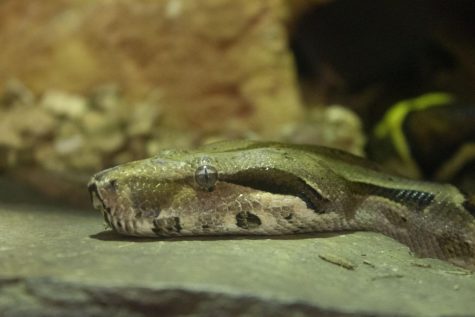A glimpse behind the glass: The animals of Science I
January 22, 2020
Since 1998 the Science I building has been educating CWU students. On both sides of the lobby, various tanks and terrariums have lined the walls for over a decade. There’s a boa constrictor, a snapping turtle and even a replica of a local rattlesnake den with live rattlesnakes.
Jonathan Betz, a technician for the biology department and CWU graduate, oversees animal care and the greenhouse. He came to CWU to become a technician because of his passion for the natural world.
“I think most people have an interest in living things. We all kind of gravitate towards animals in particular,” Betz said. ”It’s very rare that anyone would not want to see some really fascinating animals.”

Betz is not the only member of the biology department whose passion has helped cultivate the animal display in the lobby of Science I. Daniel Beck, a biology professor, is largely responsible for the animal displays. The rattlesnakes were part of various studies conducted by graduate students and were unable to be released into the wild for risk of contamination from their time in captivity. After the research was completed there was a new challenge.
“Suddenly we ended up with like 15 rattlesnakes,” Beck said. “They were in all these individual boxes. It was kind of a mess, they weren’t happy, it wasn’t an ideal situation.”
In response to the rattlesnakes’ boxed up living situation Beck decided to put his skill set to use. As a former carpenter and cabinet maker, Beck had the skills necessary to build a new rattlesnake enclosure.
When he was on sabbatical he had an idea. Beck collected basalt and recreated a rattlesnake den. Before the renovations, the rattlesnakes lived in boxes. Now, they have their very own den.
If you find yourself encountering a rattlesnake in the wild and being bitten, Beck has some advice: don’t worry too much, it’s not instant death. There is a 50% chance there is no venom in the bite.
When a rattlesnake bites a human it’s for defense, according to Beck. The snake is not trying to eat you, so they are unlikely to inject a ton of venom.
“There’s a 99% probability that it’s not going to kill you,” Beck said. “While rattlesnakes have the potential to cause serious harm to an individual they do not go out seeking to bite humans.”
There are far more animals to see than just the rattlesnakes,including Snappy the snapping turtle. Snappy hatched from an egg on CWU’s campus.
Ever since former faculty member Robert Weaver helped bring Snappy into the world, the turtle has been on campus for well over a decade. Students from all majors have the opportunity to enjoy these animals. Breanna Larson is a law and justice major and is a big fan of Snappy.
“I really love the snapping turtle because it is one of the few animals on the planet that can live up to 100 years old,” Larson said.


